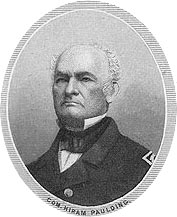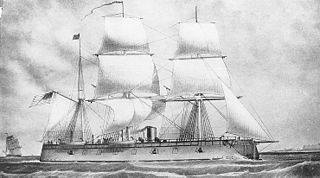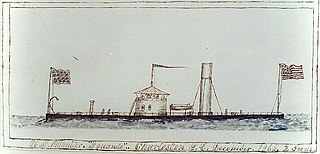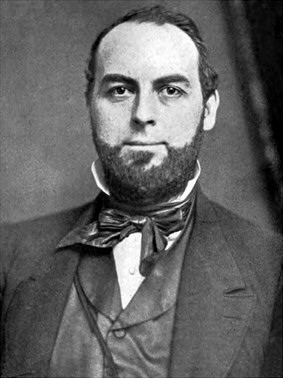
USS Monitor was an ironclad warship built for the United States Navy during the American Civil War and completed in early 1862, the first such ship commissioned by the Navy. Monitor played a central role in the Battle of Hampton Roads on 9 March under the command of Lieutenant John L. Worden, where she fought the casemate ironclad CSS Virginia to a stalemate. The design of the ship was distinguished by its revolving turret, which was designed by American inventor Theodore Timby; it was quickly duplicated and established the monitor class and type of armored warship built for the American Navy over the next several decades.

John Ericsson was a Swedish-American inventor. He was active in England and the United States.

A monitor is a relatively small warship that is neither fast nor strongly armored but carries disproportionately large guns. They were used by some navies from the 1860s, during the First World War and with limited use in the Second World War.

The Battle of Hampton Roads, also referred to as the Battle of the Monitor and Merrimack or the Battle of Ironclads, was a naval battle during the American Civil War.

An ironclad was a steam-propelled warship protected by steel or iron armor constructed from 1859 to the early 1890s. The ironclad was developed as a result of the vulnerability of wooden warships to explosive or incendiary shells. The first ironclad battleship, Gloire, was launched by the French Navy in November 1859, narrowly preempting the British Royal Navy. However, Britain built the first completely iron-hulled warships.

HMS Captain was a major warship built for the Royal Navy as a semi-private venture, following a dispute between the designer and the Admiralty. With wrought-iron armour, steam propulsion, and the main battery mounted in rotating armoured turrets, the ship was, at first appearance, quite innovative and formidable. However, poor design and design changes resulted in a vessel that was overweight and ultimately unstable. In terms of seaworthiness she was reported as closely comparable to the higher freeboard turret-ship HMS Monarch, but her reduced freeboard added a sense of "sluggishness". The Captain capsized in heavy seas, only five months after being commissioned, with the loss of nearly 500 lives.

USS Galena was a wooden-hulled broadside ironclad built for the United States Navy during the American Civil War. The ship was initially assigned to the North Atlantic Blockading Squadron and supported Union forces during the Peninsula Campaign in 1862. She was damaged during the Battle of Drewry's Bluff because her armor was too thin to prevent Confederate shots from penetrating. Widely regarded as a failure, Galena was reconstructed without most of her armor in 1863 and transferred to the West Gulf Blockading Squadron in 1864. The ship participated in the Battle of Mobile Bay and the subsequent Siege of Fort Morgan in August. She was briefly transferred to the East Gulf Blockading Squadron in September before she was sent to Philadelphia, Pennsylvania for repairs in November.

Turret ships were a 19th-century type of warship, the earliest to have their guns mounted in a revolving gun turret, instead of a broadside arrangement.

Hiram Paulding was a rear admiral in the United States Navy, who served from the War of 1812 until after the Civil War.

USS New Ironsides was a wooden-hulled broadside ironclad built for the United States Navy during the American Civil War. The ship spent most of her career blockading the Confederate ports of Charleston, South Carolina, and Wilmington, North Carolina, in 1863–65. New Ironsides bombarded the fortifications defending Charleston in 1863 during the First and Second Battles of Charleston Harbor. At the end of 1864 and the beginning of 1865 she bombarded the defenses of Wilmington in the First and Second Battles of Fort Fisher.

USS Puritan was one of two ocean-going ironclad monitors designed by John Ericsson during the American Civil War of 1861–1865. Launched in mid-1864, construction was suspended sometime in 1865. The Navy Department had specified two twin-gun turrets over Ericsson's protests, but finally agreed to delete the second turret in late 1865. The Navy Department evaded the Congressional refusal to order new ships in 1874 by claiming that the Civil War-era ship was being repaired while building a new monitor of the same name.

The first USS Casco was the first of a class of twenty 1,175-ton light-draft monitors built by Atlantic Works, Boston, Massachusetts for the Union Navy during the American Civil War.

The first USS Naubuc, laid down as a 1,175-ton light-draft monitor at Perine's Union Iron Works, Williamsburgh, NY, was launched 19 October 1864. However, as with others of her class, she was of faulty design and was found to be unseaworthy prior to her completion. She was then converted to a torpedo boat, 4th rate, with one XI-inch Dahlgren smoothbore, and arid Wood-Lay spar torpedo equipment.

USS Nausett, a single-turreted, twin-screw monitor, was built by Donald McKay, South Boston, MA, and launched on 26 April 1865, and commissioned on 10 August 1865, Acting Master Win. U. Grozier in command. Soon after her commissioning, she steamed to New York, NY, where she decommissioned on 24 August 1865, and was laid up at the New York Navy Yard.

USS Chimo, a single-turreted, twin-screw monitor, was built by the Aquila Adams company in South Boston, Massachusetts, and launched 5 May 1864, and commissioned 20 January 1865.

USS Squando was a Casco-class light draft monitor built during the American Civil War. Designed for service in rivers, the class required design changes due to the lack of seaworthiness of the first Casco-class vessel. Squando required her deck to be raised 22 inches (56 cm) before completion in order to provide more freeboard. Launched in late December 1864 or early January 1865, she was commissioned on June 6, 1865. Completed after the American Civil War had wound down, she served in the North Atlantic Squadron in 1865 and 1866 before being decommissioned in May of the latter year. After being renamed twice in 1869, she was sold in 1874 and then broken up.

The casemate ironclad was a type of iron or iron-armored gunboat briefly used in the American Civil War by both the Confederate States Navy and the Union Navy. Unlike a monitor-type ironclad which carried its armament encased in a separate armored gun deck/turret, it exhibited a single casemate structure, or armored citadel, on the main deck housing the entire gun battery. As the guns were carried on the top of the ship yet still fired through fixed gunports, the casemate ironclad is seen as an intermediate stage between the traditional broadside frigate and modern warships.

Cornelius Scranton Bushnell was an American railroad executive and shipbuilder who was instrumental in developing ironclad ships for the Union Navy during the American Civil War.

The Casco-class monitor was a unique class of light draft monitor built on behalf of the United States Navy for the Mississippi theatre during the American Civil War. The largest and most ambitious ironclad program of the war, the project was dogged by delays caused by bureaucratic meddling. Twenty ships of the class were eventually built at great expense, but proved so unseaworthy when trialed that they were quickly sidelined, causing a public scandal.

USRC Naugatuck was a twin-screw ironclad experimental steamer operated by the U.S. Revenue Cutter Service during the American Civil War. She served the U.S. Treasury Department as the USRC E.A. Stevens, a name she retained until sold in 1890. She was loaned to the Navy by the Treasury Department and thus mistakenly referred to in U.S. Navy dispatches during early 1862 as "USS Naugatuck".



















